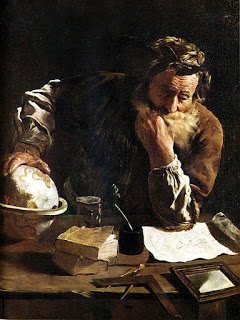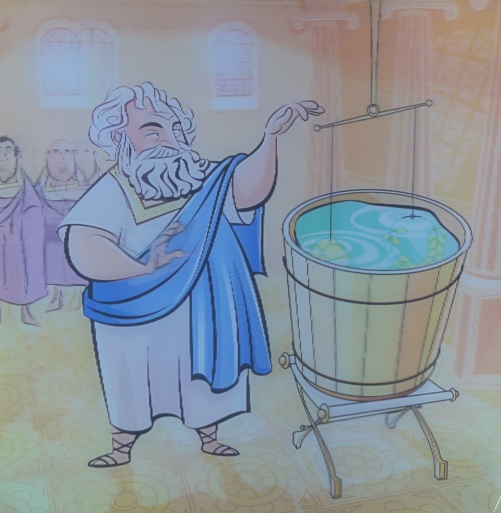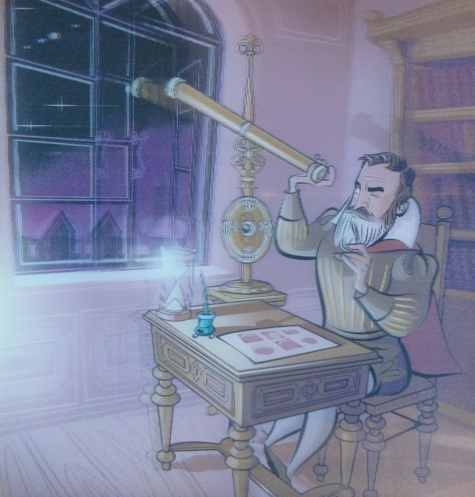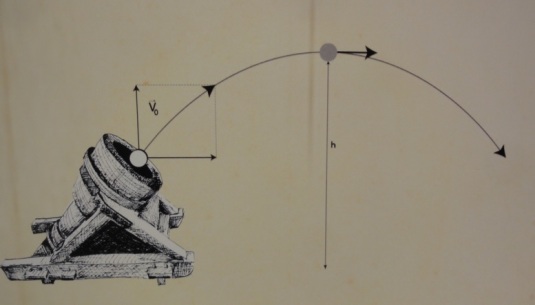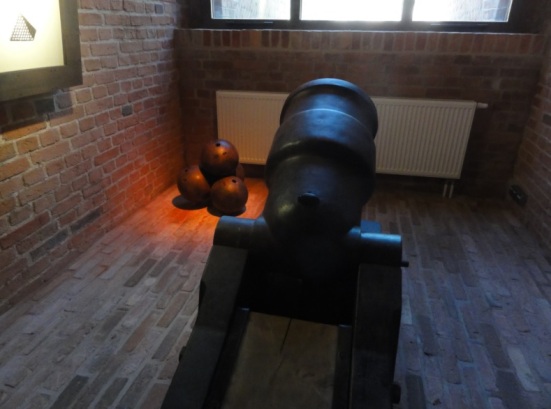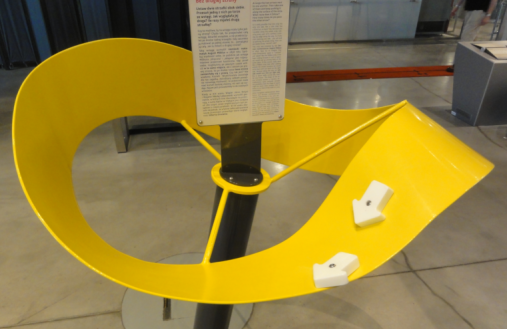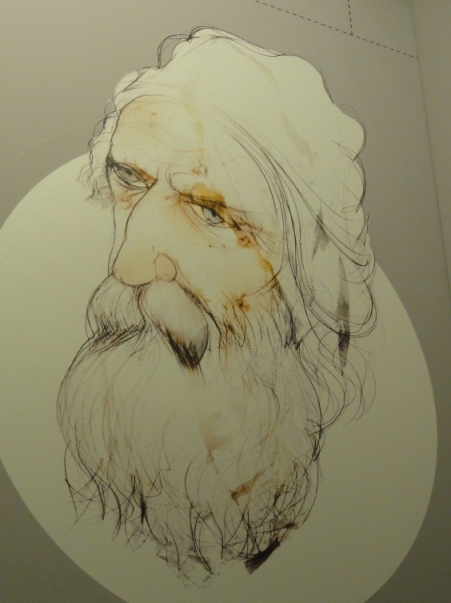
Library of the monastery
Source: Wikimedia Commons
The King Philip II of Spain decided in 1550’s that he wanted to have a great library near his court in Madrid and he chose the new Monastery of San Lorenzo de El Escorial to place it in spite of other bigger villages. He didn’t want that the new library was a regular room inside a monastery so it had to be a very important place. Therefore, the library was placed on the second floor of the monastery just above his royal chambers but never above the basilica. Between 1565 and 1576, the king bought almost 5.000 books and manuscripts and the library became one of the most important libraries in all Europe.

Imaginary portrait of Juan de Herrera (1791) from
the book “Retratos de Españoles ilustres“
Source: Wikimedia Commons
The mathematician and architect Juan de Herrera (1530-1597) designed a large room (54 m. long x 9 m. wide x 10 m. high) with big windows in both sides under a great barrel vault. This vault had to be decorated by an important painter and Philip II decided that Peregrino Tibaldi (1527–1596) had to be the right artist to do the work. Philip II was advised by Juan de Herrera and other humanists and he decided that the main subject of the paintings of the vault had to be the Liberal Arts. Furthermore, the seven arts would be together with the Philosophy and the Theology on both ends of the room. The Philosophy represented the compendium of the Human knowledge and she is accompanied by Aristotle, Plato, Seneca and Socrates:

The Philosophy
The Theology is on the side next to the convent and she represented the Divine knowledge. Therefore the vault represented the way from the Human Philosophy to the Divine knowledge through the seven Liberal Arts: the Arithmetic, the Geometry, the Astronomy (Astrology), the Music, the Rhetoric, the Grammar and the Dialectic. We can see a mathematical detail on the fresco below the Philosophy: it represents the School of Athens and there is a discussion between the Academics leaded by Socrates and the Stoics leaded by Zeno of Elea.

The School of Athens
The scholars aren’t listening to the speakers because each of them is “playing” with something different. We can see at the lower left corner a man measuring something with a compass and two books, a sphere and an armilar sphere, a dodecahedron and a compass in the middle of the picture:

Detail of the School of Athens
Going from the Philosophy to the Theology, we arrive at the Arithmetic after admiring the Grammar, the Rhetoric and the Dialectic. The Arithmetic is a woman turned to a table with simple mathematical operations rounded by muscled young men with tablets with arithmetical operations ans counting with their fingers:

The Arithmetic
There is also a representation of the Queen of Saba talking with King Solomon According to the Book of the Kings (I,10,1), the Queen of Saba went to meet Solomon to ask some enigmas to him so we can see a ruler, a balance and a tablet with some numbers written on it. In the red tablecloth we can read “Everything has number, weight and measure” in Hebrew:

King Salomon and the Queen of Saba talking about numbers
The other panel next to the Arithmetic represents the school of the Gymnosophists who lived near the Nile and thought their philosophical theories from the numerical computations. In the middle of the picture we can see one of the gymnosophist with a compass looking at a triangle with the word “Anima” and the arithmetic progression 1, 2, 3 and 4 and the geometric 1, 3, 9 and 27 written on it. The other gymnosophists are computing with numbers written on the sand:

The Gymnosophists
Finally, at both sides of the Arithmetic on the roof we find four people related with this subject: Archytas of Tarentum (c.428–c.347 BC) and Boethius (c.480-c.525) in one side and the Platonic Xenocrates (c.396/5 – 314/3 BC) and Jordan in the other. They are writing numbers in their tablets.
There is the Music after the Arithmetic and we find the Geometry after it:

The Geometry
She has a compass in one of her hands and the young men around her have different geometrical instruments. The two scenes which are on the corresponding walls next to her are dedicated to some Egyptian monks drawing geometrical figures on the sand…

Egyptian monks measuring the lands
and Archimedes’ death:

Archimedes’ death
Notice that Archimedes is drawing the demonstration of the Theorem of Pythagoras made by Euclid!
Finally, the four chosen figures are the Astronomer Aristarchus of Samos (IIIrd c. BC) and the Persian astrologer Abd del Aziz also known as Alcabitius (Xth century) in one side and Archimedes (c.287-212 BC) and Regiomontanus (1436-1476) in the other. Aristarchus is measuring angles and has a dodecahedron at his feet, Alcabitius has a carpenter’s square, Archimedes has a compass and a sphere to measure the Earth and Regiomontanus is pointing at a dodecahedron.
The last Liberal Art is the Astrology. She is backed on a terrestrial globe and her eyes are looking at the sky. She has a compass in one of her hands and the little boys around her have an armilar sphere and some astronomical books:
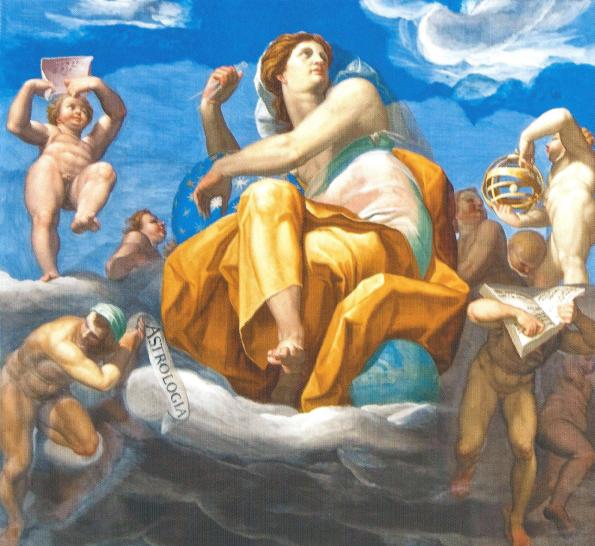
The Astrology
In one of the two panels on the walls we can see Dionysius the Areopagite observing a solar eclipse the day of Jesuschrist’s death in Athens (Luke, 23,45) We can notice a quadrant and an astrolabe in the hands of the amazed men!
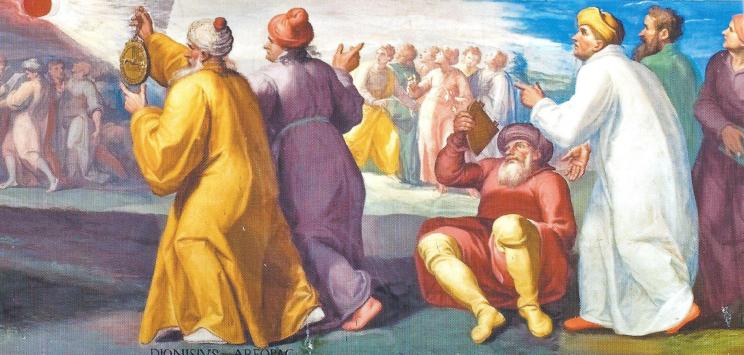
Dionysius the Areopagite observing a solar eclipse
The other fresco represents King Ezekiel resting in bed and looking how time is delayed 15 years by God because of the repentance of his sins:

Ezekiel resting in bed
The four famous men are Euclid, Ptolemy, Alfonso X and Johannes of Sacrobosco. Euclid is represented here meaning the relationship between Astrology and Geometry. He has drawn three geometrical schemes. One is a triangle and a square inscribed in a circle and another square. Another scheme seems to be two overlaid squares partially hidden by Euclid’s name. In the middle of both pictures there is a man measuring the stars. Johannes of Sacrobosco has a quadrant in his right hand.

Euclid and Johannes of Sacrobosco
King Alfonso X of Castile (XIIIth. c) is the author of the Libros del Saber de Astronomía (“Books of the Astronomical knowledge”) and on the tablet which he has in his hands we notice a compass and the Ursa Maior (the compass is anachronistic!). His left hand has an open book with a horoscope

Alfonso X
So you can see that this wonderful vault is an open mathematical book designed by Tibaldi and Juan de Herrera. I’ve been twice in the library and now I am waiting for the next time that I could enjoy this artistic part of the monastery of San Lorenzo de El Escorial.
Location: San Lorenzo de El Escorial (map)
